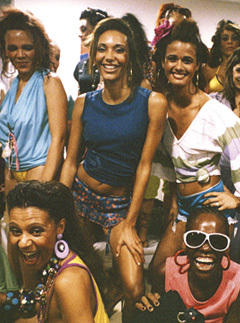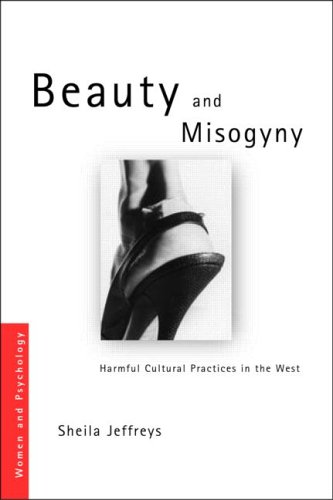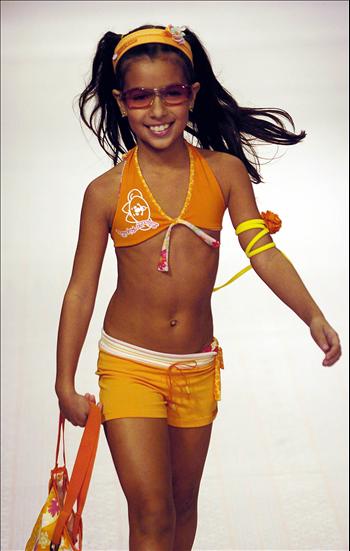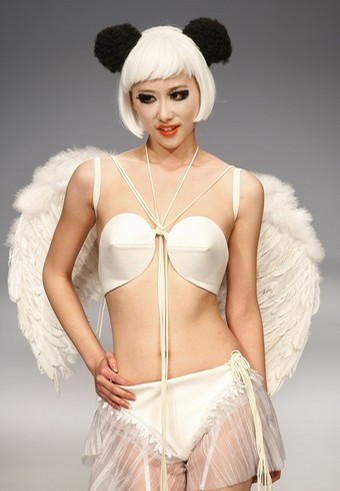| Prostitution in the Fashion Industry
The Fashion eZine - Modelling
From Runways to Redlight DistrictsEurope is a wonderful place to be a fashion designer, photographer or model. Or so the fashion industry tells us. There are always plenty of opportunities for a pretty girl to make some money showing off some clothes and some skin. But not according to former fashion editor Louise Gagnon and several models who have since quit the industry and have described as the seedy underbelly of the fashion industry. An industry filled with illicit drugs, prostitution, forced anorexia and mental/physical abuse. Prostitution, of course, is nothing new. The industry is ever changing and broad reaching around the globe, from the streets of Thailand to high class London escorts, to the outrageous parties of Las Vegas - wherever there is money to be made off of men, prostitution is there - with many of its far reaching social aspects. Thus there is no surprise that prostitution permeates the fashion industry like termites in a tree. Most people simply would not assume there would be any such connections between the fashion world and the darker world of drugs and prostitution - the fashion industry has a tendency to gloss over anything that gives the industry a bad rep - including anorexia within the modeling industry. Though it may disturb some individuals, Louise Gagnon’s story deserves to be heard. Louise now lives in sunny south California where she makes custom wedding dresses for high paying clients, but her introduction to the fashion industry was as a model during the 1980s. She was 18 years old when she began modelling in Paris in 1983, and while her time on the runways and in front of the camera was short she managed to leverage her way into an assistant editor position at a French fashion magazine, but not before becoming addicted heroin and doing a variety of photo shoots she'd rather not remember and has difficulty discussing. "I was raped regularly. Sometimes multiple times per week. I was depressed all the time and the only thing that made me feel better was the heroin. It didn't stop when I stopped modelling either. I was in some bad relationships with the photographers who I had met years earlier and I was involved with them professionally so I had to ignore my feelings. It was complicated and I became more and more disgusted at myself everyday. I finally decided I needed to quit before I killed myself." - Louise Gagnon. Louise got help with her drug addiction and since quitting the industry in 1999 she has spoken out from time to time on issues of prostitution, rape and drug addiction in the fashion industry. She says she is not alone with these problems either and says that the problems are industry wide and recalls shooting heroin with models and being in "rape orgies" with male friends of the photographers and other models. "One of my friends was out of control. She would do a fashion shoot in Paris in the afternoon or morning and hop a train to Amsterdam so she could be in the redlight district by evening. She thought of it as a career, but when her body turned up in a canal in 1998 I started getting really paranoid. I mean, that could have easily been me." - Louise Gagnon.
Carré OtisHardly the only one speaking out on this matter Carré Otis is a former supermodel who survived anorexia, heroin/cocaine addiction, and repeated rapes. Prior to her 1999 heart seizure her drug addiction was getting steadily worse, she was surviving on green tea and small doses of vegetarian food, and she was easily persuaded into drugs and unsolicited sex because she couldn't say no to the people paying for her expensive lifestyle. Her abusive husband Mickey Rourke didn't help either. Rourke was jealous of Carré Otis's relationships with several fashion photographers (several of which raped her) and beat her on multiple occasions. In 1991 Carré Otis got a gunshot wound to her shoulder during a visit with Rourke in Santa Fe, New Mexico. She later claimed that the .357 Magnum went off when she dropped her purse on a table. On July 18th 1994, Otis was slapped, knocked down, and kicked in a Hollywood office by Mickey Rourke. Rourke was charged but Otis refused to testify against him in court. They divorced the same year. Following her divorce her career as a fashion supermodel continued to take off, but her private life was one of constant drug addiction and repeated rapes from people she was employed with. The fashion industry likes to keep a lid on these events however and no "reputable fashion magazine" would dare talk out against all the problems going on in the industry. Its not so much that the fashion industry is a prostitution ring in disguise, but that it is a group of people that collectively has decided to exploit the models sexually and mentally using a combination of peer pressure, money, drugs and mental mind games. That combination is turning out to be lethal for the models who get over their heads with anorexia problems and drug addiction, but adding prostitution/rape to the list of personal problems just makes things so much more complicated. To leave the industry a model would have to simultaneously cut off all contact with the people who are a bad influence. This can be done as Carré Otis has already demonstrated. This process can be made easier by trying to change your focus in the industry. Carré Otis put on 30 lbs and became a model for larger sizes while Louise Gagnon switched to fashion magazines and switched again to the wedding industry. Obviously its difficult to leave the industry entirely, but there are other aspects of the industry that aren't so corrupted by wealth and power.
And the ReversalFashion models aren't the only people with this unusualy problem. In 2007 Marie Claire published an article about Brazilian prostitutes who have quite the sex industry in favour of the fashion industry. The article focused on the new fashion label Daspu (short for 'das putas' which means 'from the whores') and a mockery of Daslu, Brazil's most expensive fashion boutique. All of the models and designers for Daspu are former prostitutes who sold their bodies for as little as $30/hour. Prostitution is not illegal in Brazil, but the Penal Code criminalises 'agents of prostitution' – pimps, brothel owners and madams. Daspu hopes to help prostitutes to get out of their abusive relationships with their pimps and try something that doesn't involve doing cheap tricks for money. The brainchild is former prostitute former prostitute Gabriela Leite, now 54, who became a prostitute at the age of 20, but later became political active. "I became politically active in 1978, when police murdered my friend for being a prostitute. That year, there was a police crackdown and we were banned from leaving our building, but my friend went out anyway. They arrested her, took her to the police station and beat her to death." - Gabriela Leite. Leite organized a protest agains the police and the officer who beat her friend to death was eventually dismissed from the force. Since then she has kept on marching and trying to help prostitutes secure more rights, more safety and to help them get out of the business. Although certainly not the stay-at-home kind Gabriela Leite now has two daughters and a granddaughter and continues to fight to change the system.
X-Rated FashionNot all fashion models are prostitute (or former prostitutes like the example above), but when you look at some of the centerfolds models do for men's magazines you realize that some of the models are taking it a step farther into the porn industry. They aren't even marketing a fashion article or perfume anymore, they're marketing themselves as sex objects. Supermodel Tila Tequila Nugyen for example has openly embraced the porn industry and is trying to market herself as a supermodel, a porn star and a musician. Lest we forget we now live in an era where celebrity sex idols (ie. Paris Hilton and Pamela Anderson) routinely make homemade sex videos that accidentally get leaked to the public and despite this turns them into even bigger celebrities. In Paris Hilton's case it made her career and she has since leveraged herself into fashion and music deals. |
|
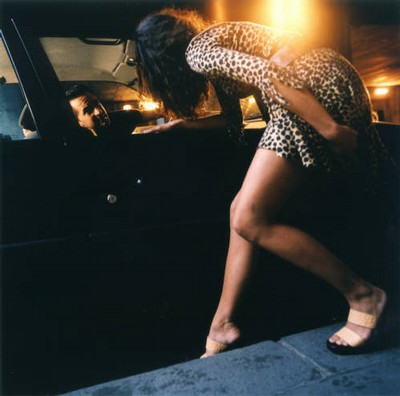
AmsterdamEurope's prostitution centre, the famed city of Amsterdam, is trying to overhaul its redlight district between now and 2012 by turning it into a fashion district. Amsterdam Mayor Job Cohen thinks that by replacing the district with fashion shops that there will be less demand for prostitution and more tourists who just like to shop. Mariska Majoor, a former prostitute who now runs the Prostitution Information Centre, is skeptical of the idea. "That story about the fashion industry coming to the red light district is laughable," Majoor says. She said Cohen's claim that "if there's less supply, there will be less demand" for prostitution was wrong, and predicted that closing brothels would merely increase the number of street walkers. Majoor predicts the city would be able to push prostitution away from Central Station, but doubts that a "clean" red light district free of criminality and full of thriving businesses is realistic. "This is definitely not going to turn into some wonderful Walt Disney story," she says. "The city is simply going to wipe some things off the table and say that what you don't see doesn't exist."
Beauty and Misogyny
Author Sheila Jeffreys has written a book (Beauty and Misogyny: Harmful Cultural Practices in the West) in which she points out that the fashion industry and the porn industry are becoming cross connected. "The sex industry sells clothes and the fashion industry sells prostitution and pornography." And she's not the only author with this assessment. Madonna's pro-prostitution "Sex" book in which she discusses ideas that prostitution gives women control over men. Although realistically this is Madonna's fantasy version in which the prostitutes are wearing stilletos and lingerie while the men are handcuffed to the bed. And that is exactly what it is, Madonna's fantasy, and is totally out of touch with reality. The myth that prostitutes hold sexual power over men is completely bogus and in turn simply serves to enforce male dominancy over prostitutes who are led into the false assumption that they are somehow in control. Research into sex industry by Giobbe (1991), Parriott (1994) and Farley (1998) all concluded that the vast majority of prostitutes want to get out of the business and were dragged into the sex industry by boyfriends/pimps often because they were in a similar industry such as stripping, modelling, acting, massage therapy and advertising.
Child Fashion Models
The most despicable and disturbing of all is the child models. We can only imagine the kind of mental damage children in the fashion industry are going through when being asked to pose scantily clad on runways and in front of cameras. Parents of the children have to be extra wary about sending their children to work for photographers, who despite their possibly great reputations are always one or two steps away from being a child rapist. Chaperones are a definite must and if the parents are disturbed by what they are seeing too much of it is certainly time to pull the plug. Mind you the damage to the child's psyche might already be done. And its not just the girls who are in danger, the boys are also prone to gay pedophiles. For all we know members of the Catholic Church like to find their "choir boys" by searching the child modelling agencies for young boys. We shouldn't be too surprised if it is true. In Thailand there are more underage prostitutes than there is anywhere else in the world. In stark contrast Thailand's child modelling industry is basically non-existent.
ConclusionsSo is the fashion industry just a big prostitution ring in disguise? No. Absolutely not. But there is certainly a lot of prostitution going on behind closed doors, and it is basically legalized prostitution for the wealthy. In many countries prostitution is illegal, but it is not strictly inforced. The prostitutes get away with it and charges are rarely laid. Conviction rates for "Johns" are pathetically low because it is often difficult to determine whether any crime has been convicted. Fashion models create a legitimate front because they're supposed to be advertising something (clothes, beer, shopping bags, perfume, etc.) but in reality are selling their bodies as a form of cheap entertainment, usually just visually, but they can also be selling themselves regularly behind closed doors.
Part of the problem is the belief that anorexia is beautiful, and fashion models being the epitome of this, attract a certain kind of man who is looking for the ultra-thin models and is willing to pay extra for it. There is some prestige involved with saying "I fucked Naomi Campbell" or "I had a 69 with Tyra Banks". It is a bit like "Eyes Wide Shut", the Tom Cruise/Nicole Kidman movie in which they discover a secret society of wealthy people who employ high-class models to have wild sex orgies. What happens in real life is probably not that different from what goes on in that movie. Take away the cloak and dagger stuff, and the international modelling and fashion industry really becomes quite sleazy. Police in France and Britain have cracked down on prostitution within the modelling industry, but it still continues to flourish. People like money and sex, so the world's oldest profession is very hard to stop. Speaking out against prostitution in the fashion industry doesn't help a person's career. People are expected to stay quiet or have their careers ruined. Apparently if anyone breaks this code of silence, they become ostracized from much of the modelling community. Some people will tell you that there is no prostitution in the fashion industry, that they've been in the fashion industry for years and they've never encountered prostitution or rape in their business. Some will also tell you that if two consenting adults, a model and a photographer, decide to have sex after the shoot is over it is really none of your business and that isn't prostitution because they both agreed to it. Or even the analogy that actresses sleep with movie directors/producers regularly (and sometimes they marry them) and that doesn't make them prostitutes. But they can't all be right. You have to admit sexual attraction does happen, so there is going to be sex in the industry, it is simply to be expected. And you can't expect the model to be not be thinking "Hey, if a screw this guy will he pay me more or hire me again?" or "If I do this will it help my career?" It is a slippery slope downhill. | |


